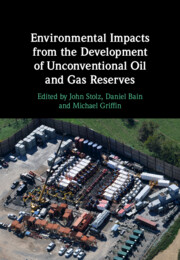Book contents
- Environmental Impacts from the Development of Unconventional Oil and Gas Reserves
- Environmental Impacts from the Development of Unconventional Oil and Gas Reserves
- Copyright page
- Contents
- Figures
- Tables
- Contributors
- Preface
- Part I Overview
- Part II Environmental Analysis
- 5 Air Quality
- 6 Methane and Climate Change
- 7 Water Usage and Management
- 8 Seismicity Induced by the Development of Unconventional Oil and Gas Resources
- 9 Naturally Occurring Radioactive Material (NORM)
- 10 Metal Isotope Signatures as Tracers for Unconventional Oil and Gas Fluids
- 11 Isotopes as Tracers of Atmospheric and Groundwater Methane Sources
- 12 The Microbiology of Shale Gas Extraction
- Part III Case Studies
- Index
- References
12 - The Microbiology of Shale Gas Extraction
from Part II - Environmental Analysis
Published online by Cambridge University Press: 28 July 2022
- Environmental Impacts from the Development of Unconventional Oil and Gas Reserves
- Environmental Impacts from the Development of Unconventional Oil and Gas Reserves
- Copyright page
- Contents
- Figures
- Tables
- Contributors
- Preface
- Part I Overview
- Part II Environmental Analysis
- 5 Air Quality
- 6 Methane and Climate Change
- 7 Water Usage and Management
- 8 Seismicity Induced by the Development of Unconventional Oil and Gas Resources
- 9 Naturally Occurring Radioactive Material (NORM)
- 10 Metal Isotope Signatures as Tracers for Unconventional Oil and Gas Fluids
- 11 Isotopes as Tracers of Atmospheric and Groundwater Methane Sources
- 12 The Microbiology of Shale Gas Extraction
- Part III Case Studies
- Index
- References
Summary
Pristine shale formations are limited subsurface microbial habitats owing to their limited physical space. However, the process of drilling and hydraulic fracturing to recover natural gas from these formations greatly enhances their habitability for microbial life. Drawing upon over a decade of research, this chapter introduces fractured shales as dynamic microbial ecosystems, with particular emphasis on microbial processes that negatively impact on shale gas extraction, including input fluid degradation, biogenic sulfide production and biofilm formation. Collectively, these processes have the potential to sour natural gas, corrode extraction infrastructure, restrict the flow of gas and generally increase costs of resource recovery. The use and efficacy of biocides to control these impacts is discussed. This review presents a biogeographical overview of the fractured shale formations studied to date, highlighting a paucity of information on fractured shales outside the United States, and concludes with a discussion on the remaining knowledge gap.
Keywords
- Type
- Chapter
- Information
- Publisher: Cambridge University PressPrint publication year: 2022

